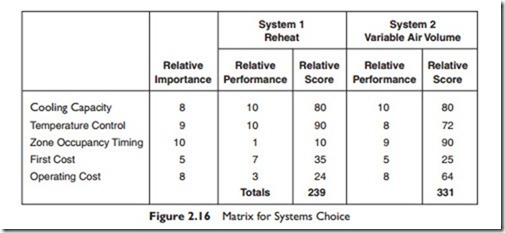System Choice Matrix
The matrix method of system choice consists of a list of relevant factors that affect system choice and a tabular method of comparing the systems under consideration.
Figure 2.16 provides an illustration of the matrix method of choosing a system. In the left column of the matrix are the relevant factors that will be used to evaluate the systems, and the top row shows the systems under consideration.
In our example, we have simplified the matrix in both dimensions. We have strictly limited our relevant factors, and we have limited our choices down to two systems, the reheat system and a VAV system. Note that in a real matrix you would include all the relevant issues, as discussed in the preceding section. You would also probably have several systems under consideration.
In this example, the relevant design issues for this building are as follows:
e The building requires cooling but no heating.
e Some areas of the building will be in use for 24 hours every day of the week. Other areas will be used just during the day, Monday to Friday.
e The client has indicated that operational expenses (ongoing) are more important than construction costs (one time).
As you can see, the matrix has a list of relevant issues down the left hand side. Each issue may have a greater or lesser importance. In the column headed “Relative importance” one assigns a multiplier between 1 and 10, with 10 meaning “extremely important” and 1 meaning “not important.” So if, for our example, temperature control is very important it might be rated “9” and the ability to Zone – which is critical to economic operation in this particular building, requires a relative importance of 10. As you can see in the matrix, it is possible for two factors to share the same relative importance.
Once the relative importances have been assigned, it is time to assess the systems under consideration. In our example, both systems have excellent cooling capacity. They each score “10” under performance for this factor.
When we consider the requirement for zone occupancy-timing, however, we note that the reheat system does not have any ability to shut off one part of the system and leave another running. Therefore, it scores only “1” for this requirement. The VAV system, on the other hand, has the capacity to shut off any zone at any time though the main fan still has to run, even if only one zone is on. Therefore the VAV system scores “9” for this factor.
The VAV system also gets a higher score for first cost (construction cost) and for operating expense.
After each factor has been considered, the “relative performance” number is multiplied by the “relative importance” multiplier, to obtain the relative score for that item. The results for each system are totaled, and compared.
In this example, the VAV has a higher score and would be chosen.
The method is an excellent way of methodically assessing system alternatives. However, it should be used intelligently. If a system fails on a critical requirement, it should be eliminated, even if its total score may be the high- est. For example, on a prison project, one would likely exclude any system that requires maintenance from the cells, regardless of how high it scored on a matrix!
